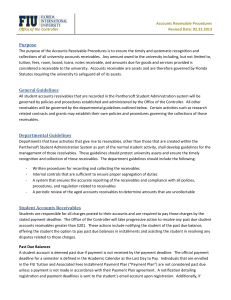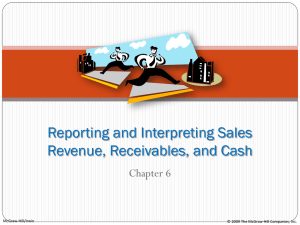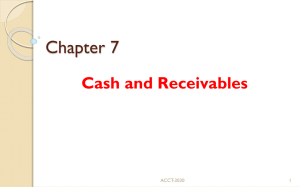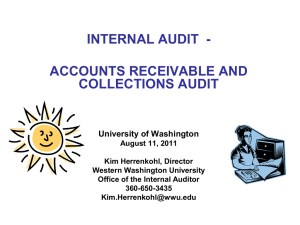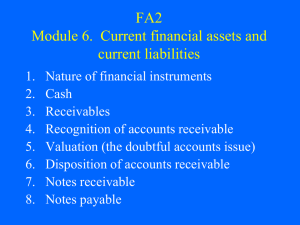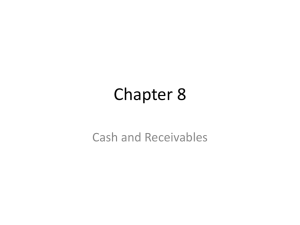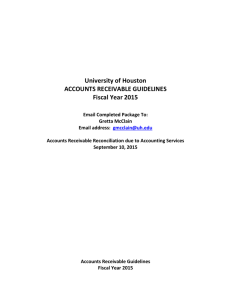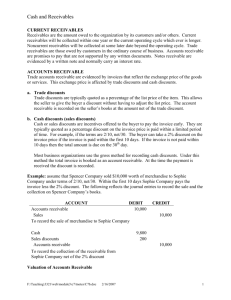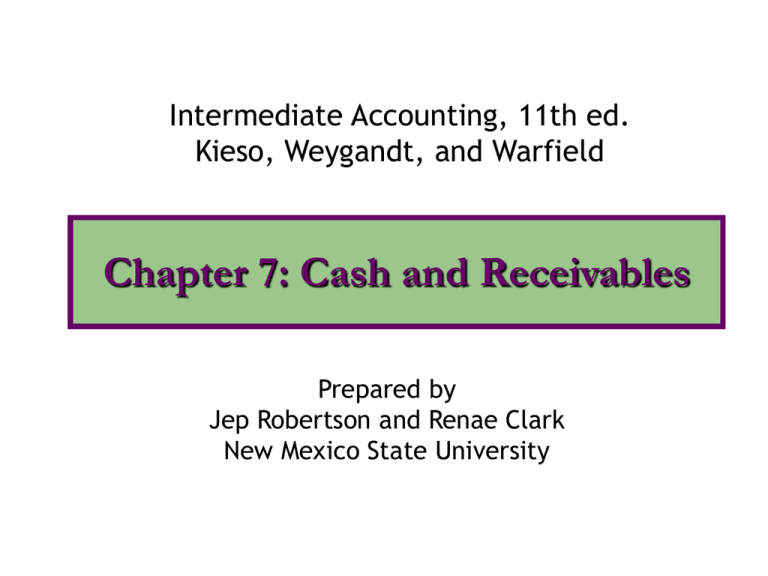
Intermediate Accounting, 11th ed.
Kieso, Weygandt, and Warfield
Chapter 7: Cash and Receivables
Prepared by
Jep Robertson and Renae Clark
New Mexico State University
Chapter 7: Cash and Receivables
After studying this chapter, you should be
able to:
1. Identify items considered cash.
2. Indicate how cash and related items are
reported.
3. Define receivables and identify the different
types of receivables.
4. Explain accounting issues related to
recognition of accounts receivable.
Chapter 7: Cash and Receivables
5. Explain accounting issues related to valuation
of notes receivable.
6. Explain accounting issues related to
recognition of notes receivable.
7. Explain accounting issues related to valuation
of notes receivable.
8. Explain accounting issues related to
disposition of accounts and notes receivable.
9. Explain how receivables are reported and
analyzed.
Cash and Cash Equivalents: Issues
• Definition of “cash”
• Management and control of cash
• Reporting of cash in the balance sheet
Items Comprising “Cash”
• Cash must be readily available and be
free of restrictions
• Cash consists of coins, currency and
available funds
• Deposits (CDs) and short term paper
are classified as temporary
investments
• Post dated checks, travel advances
and stamps on hand are not classified
as cash
Management of Control and Cash
• Since cash is the most liquid asset,
internal control of cash is imperative.
• Controls must prevent unauthorized
use of cash.
• Management must have necessary
information for proper use of cash.
Reporting of Cash
The reporting of cash depends upon
whether it is:
•
restricted cash
•
a bank overdraft or
•
a cash equivalent
Restricted Cash
Compensating balances:
• are amounts maintained by a corporation
with a bank in support of existing borrowing
arrangements.
• are identified as current assets separate
from cash, if they relate to short-term
loans.
• are identified as non-current assets
separate from cash, if they relate to longterm loans.
Bank Overdrafts
• Overdrafts represent checks written in
excess of cash account.
• Overdrafts may be offset against
available cash in another account in
the same bank.
• Otherwise, such offsetting is not
allowed.
Accounts Receivable: Issues
• Types of accounts receivable
• Recognition of accounts receivable in
the financial statements
• Valuation of accounts receivable
• Disposition of receivable
Accounts Receivable Recognition:
Recording Cash Discounts
There are two methods: Gross and Net
1. Gross method records discounts
when taken by customers.
2. Net method records discounts not
taken by customers.
Accounts Receivable: Recording
Cash Discounts
GROSS method
• Record revenue at gross
amount of sales.
• When customer takes
the discount, record
cash discounts.
• Cash discounts reduce
gross sales revenue.
NET method
• Record revenue at gross
amount of sales less
cash discount.
• When customer forfeits
discount, record
discounts not taken.
• Report discounts
forfeited as other
revenue.
Valuation of Accounts Receivable
• Short term receivables are reported at
their net realizable value (NRV)
• The NRV is the net amount expected
to be collected
• The NRV is gross accounts receivable
less estimated non-collectible
accounts.
Comparison of Methods for
Estimating Uncollectibles
Estimating Non-collectable
Receivables
Methods
Direct Write-Off
Not based on the matching
principle
Allowance
Based on the matching
principle
Accounts are written off
Estimated bad debts are
when determined non-collectible matched against revenue
Appropriate only if
amounts are not material
Must be followed if
amounts are material
Estimating Non-collectable
Accounts: The Allowance Method
The estimate of non-collectible
accounts may be based on:
1. Sales (or net sales), known as the
Income statement approach, or
2. Accounts receivable balance, known
as the Balance sheet approach.
Balance Sheet Representation
Short-term accounts receivable are
shown at their net realizable value as
follows:
• Accounts Receivable (gross):
$ XXX
less: Allowance:
($ XX)
Net Realizable Value:
$ XX
Notes Receivable: Issues
Recognition of Notes Receivable
• may be issued at face value or not at face
value
• may be issued for cash/non-cash
consideration
Valuation issues
Disposition of notes receivable
Recognition of Notes Receivable
Notes Receivable
Short term N/R
Record at face value
less allowance
Long term N/R
Record at present value
of cash expected to
be collected
Recognition of Notes Receivable
• Notes receivable are issued at face value
when the stated rate of interest is the same
as the effective (market) rate.
• If the stated rate is less than the effective
rate then a discount results.
• If the stated rate is greater than the
effective rate then a premium results.
• The discount or premium is amortized to
interest revenue by the effective interest
method.
Recognition of Notes Receivable
Issues NOT at face value
Non-interest bearing
1. Determine issue price on
notes receivable at
implicit rate of interest
2. The discount/premium is
amortized to interest
revenue by the effective
interest method
Interest bearing
1. Determine issue price on
notes receivable at
the effective rate of
interest.
2. The discount/premium is
amortized to interest
revenue by the effective
interest method
Disposition of Accounts and
Notes Receivable
• The holder of accounts or notes receivable
may transfer them for cash.
• The transfer may be:
1. a secured borrowing or
2. a sale of receivables
• Holder retains ownership of receivables in
a secured borrowing transaction.
• Holder transfers ownership of receivables
in a sale (retaining risks of collection).
Transfer of Receivables:
Borrowing vs. Sale Treatment
Conditions
1. Are transferred assets isolated
from transferor? and
2. Does transferee have right to
pledge or sell assets? and
3. Has transferor divested itself
of control through repurchase
agreement?
Yes
Sale
No
Borrowing
Accounting for Transfers of
Receivables
Transfers
Secured Borrowing
With Recourse
Continuing involvement
by
seller
Sale
Without Recourse
No continuing
involvement by
seller
Secured Borrowing (the basics)
• Transferor records a finance charge.
• Transferor collects accounts receivable.
• Transferor records sales returns and sales
discounts.
• Transferor absorbs bad debts expense.
• Transferor records interest expense on
notes payable.
• Transferor pays on the note periodically
from collections.
Sale of Receivables
• Transferor transfers ownership of
receivables to factor.
• Factor records the (transferred) accounts as
assets in its books.
• Transferor records any amount retained by
transferee as “due from factor.”
• Transferor records loss on sale of
receivables.
• Transferor records any component liability
(when appropriate).
Accounting for Transfers of
Receivables
COPYRIGHT
Copyright © 2004 John Wiley & Sons, Inc. All rights reserved.
Reproduction or translation of this work beyond that permitted
in Section 117 of the 1976 United States Copyright Act without
the express written permission of the copyright owner is
unlawful. Request for further information should be addressed
to the Permissions Department, John Wiley & Sons, Inc. The
purchaser may make back-up copies for his/her own use only
and not for distribution or resale. The Publisher assumes no
responsibility for errors, omissions, or damages, caused by the
use of these programs or from the use of the information
contained herein.

